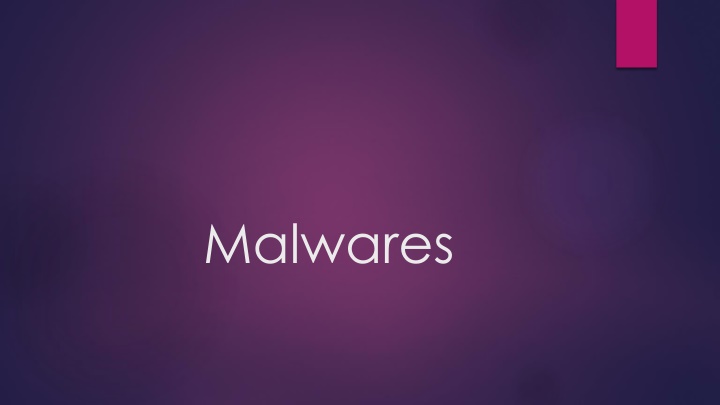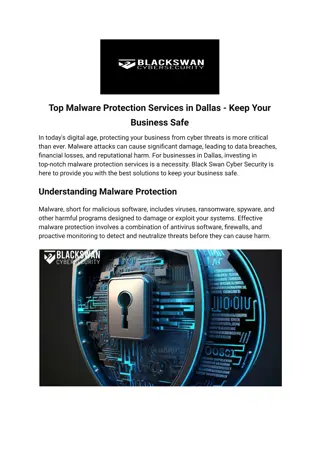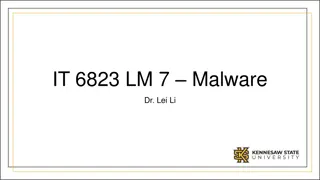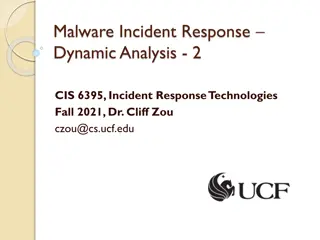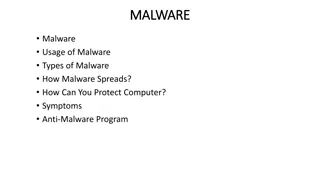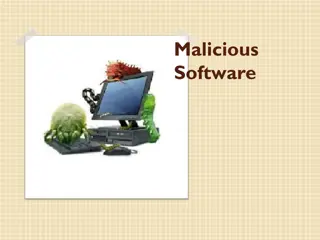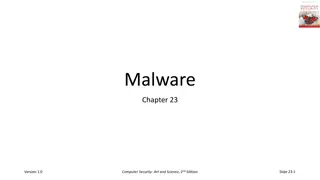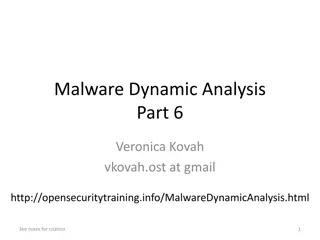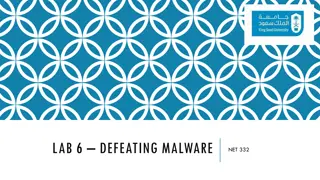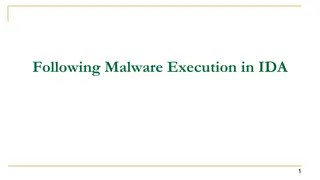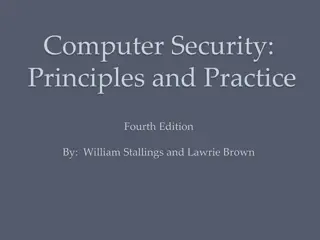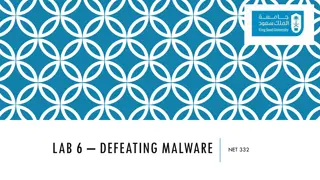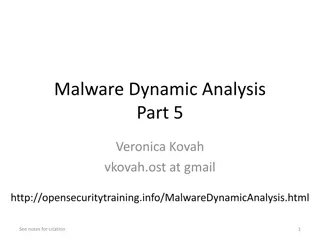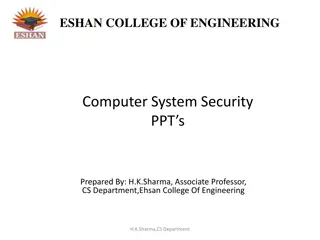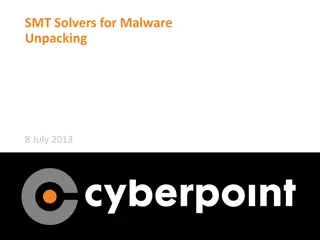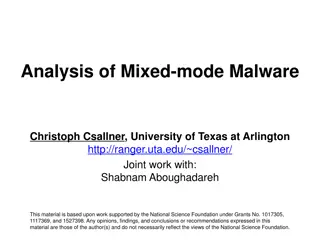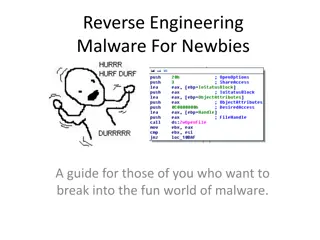Malware: Types, Risks, and Prevention
Malware, short for malicious software, is designed to disrupt, damage, or gain unauthorized access to computer systems. Malware includes viruses, worms, trojans, ransomware, adware, spyware, rootkits, keyloggers, and more. They can be spread through various means like malicious links, untrusted downloads, infected attachments, and portable devices. It's important to understand the various types of malware to protect your devices from potential threats.
Download Presentation

Please find below an Image/Link to download the presentation.
The content on the website is provided AS IS for your information and personal use only. It may not be sold, licensed, or shared on other websites without obtaining consent from the author.If you encounter any issues during the download, it is possible that the publisher has removed the file from their server.
You are allowed to download the files provided on this website for personal or commercial use, subject to the condition that they are used lawfully. All files are the property of their respective owners.
The content on the website is provided AS IS for your information and personal use only. It may not be sold, licensed, or shared on other websites without obtaining consent from the author.
E N D
Presentation Transcript
What is a Malware? Software that is specifically designed to disturb, damage, or gain unauthorized access to a computer system. These software are generally made for : Stealing, encrypting, or deleting data Altering or hijacking computing functions Monitoring computer activity Spreading automatically
How Malware reach our computers or mobiles? Clicking on a malicious link in an email Downloading a file from an untrusted source Opening an infected attachment Using an infected portable storage device on our system like Pen drive, CD/DVD, removable HDD etc.
Types of Malware 1. Viruses 2. Worms 3. Trojans 4. Ransomware 5. Adware 6. Spyware 7. Rootkits 8. Keyloggers 9. Fileless Malware 10.Cryptojacking 11.Hybrid Malware
Are all Malware Virus? No, not all malware is a virus, but every virus is a type of malware. Malware is a general term for any malicious software that can harm your device, including computer viruses.
Virus, Worms and Trojan Virus is a computer program or software that connect itself to another software or computer program to harm computer system. When the computer program runs attached with virus it perform some action such as deleting a file from the computer system. Virus can t be controlled by remote. Worms is also a computer program like virus but it does not modify the program. It replicate itself more and more to cause slow down the computer system. Worms can be controlled by remote. Trojan is a hidden piece of code which steal the important information of user. For example, Trojan horse software observe the e-mail ID and password while entering in web browser for logging.
What is an Adware? Adware is a type of malware that displays unwanted advertisements on a device. It can appear in many forms, including banner ads, videos, pop-ups, and full-screen ads. Adware is often bundled with other software and installed without the user's knowledge or consent. Its purpose is to generate revenue for the creator by serving ads to internet users.
What is Rootkit? A rootkit is a type of malicious software that gives an attacker privileged access to a computer while hiding its presence. The term "rootkit" is a combination of the words "root" and "kit", with "root" referring to the administrator account on Unix and Linux systems, and "kit" referring to the software components that implement the tool.
What is a Spyware? Spyware is a type of malicious software that secretly enters a user's device, gathers data, and sends it to third parties without their consent. It can harm the user by violating their privacy, endangering their device's security, or other means How to check if your PC/phone has a spyware : Unusual slowness, crashes, or instability Overheating, unusual battery drain, strange noises during calls, or the camera or mic turning on randomly
What is a Keylogger? A keylogger is a type of spyware that can be both hardware or software based. It secretly records everything you type on your computer or mobile device. This can include sensitive information like passwords, credit card numbers, and messages. Records Keystrokes This recorded data can be stored on the device itself or sent to a remote server. Attackers can then use this stolen information for various malicious purposes, such as identity theft, financial fraud, or hijacking your online accounts.
What is a Ransomware? Ransomware is a type of malware that prevents a user from accessing their device or data until they pay a ransom. It can infect a device through malicious links, attachments, or other means, such as phishing or removable USB drives. Once a device is infected, the ransomware can lock the computer, encrypt the data, or steal or delete it. The attackers may also threaten to leak the stolen data.
What after Ransomware attack Report the incident to cyber crime unit / cell or local police. Explore Decryption Options Recover your system from a recent backup . Recover your files from cloud or other backup storage. Do not surrender to the attacker and do not pay any amount to him/her. Conduct Post-Incident Review.
How to know if our security is compromised? Unusual Device Activity Device getting heated-up Slow Performance Account Issues Security Software Alerts Phishing Attack or e-mails from unfamiliar senders asking for re-login etc. Unfamiliar icons on the desktop New plugins or extensions in your browser
Precautions from Malware Install a good security software (antivirus) Keep your antivirus updated Use a firewall Be careful about what you click on Use a strong password Be cautious about free software Disable unused features Educate yourself Backup your data
How to deal, if our system gets affected by malware Disconnect from the internet Isolate the infected device Run a security scan Consider a deeper scan Change password Consider a clean reinstall (if necessary)
